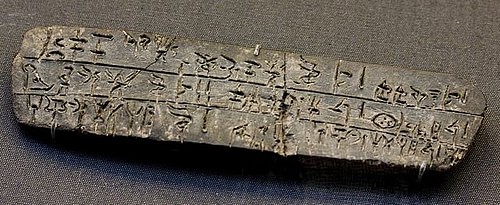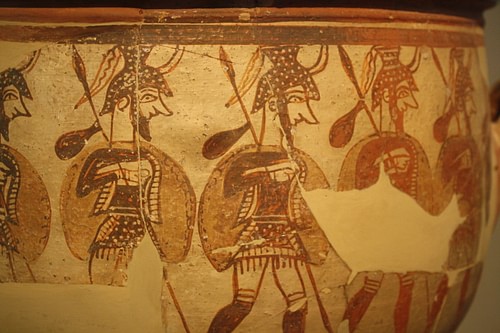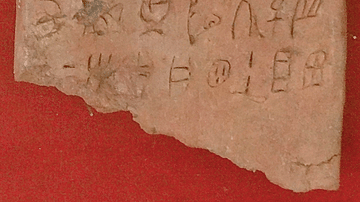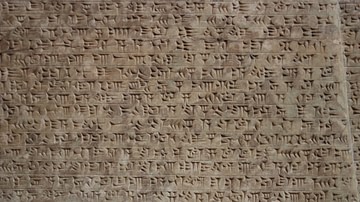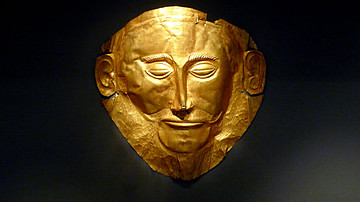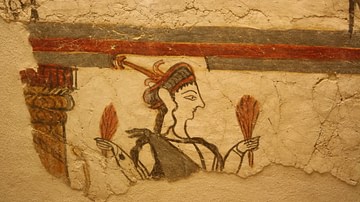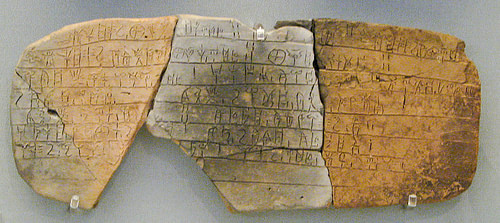
Linear B Script was the writing system of the Mycenaean civilization of the Bronze Age Mediterranean. The syllabic script was used to write Mycenaean Greek from c. 1500 to c. 1200 BCE. It was deciphered by Michael Ventris in 1952, and so the script has provided invaluable insights into the Mycenaean culture and its interaction with contemporary Mediterranean civilizations.
Early Aegean Syllabic Scripts
Two scripts of note were already in use in the Bronze Age Aegean before the Linear B script. These were Cretan Hieroglyphic script, in use from around 2000 to 1650 BCE, and Linear A script, in use from around 1850 to 1450 BCE. Both scripts were used by the Minoan civilization (c. 2000 to c. 1450 BCE) centred on Crete and spread to other islands such as Thera, Rhodes, and the Cyclades group. Neither of these scripts has yet been deciphered, but we do know that they were used for administrative and religious purposes, most often as inscriptions on clay tablets. While the Cretan Hieroglyphic script gradually went out of favour, the Linear A script was in use across Crete by the late 16th century BCE. Linear A script is composed of at least 90 characters, which can be grouped into syllabic signs, ideograms, and symbols which denote numbers and fractions. In addition, monograms were made from the clustering of two or three symbols. Around 70% of Linear A symbols reappear in the Linear B script of Mycenaean Greece. Just as the Mycenaean civilization of mainland Greece came to culturally dominate and appropriate elements of Minoan culture from the mid-15th century BCE, so too elements of the older Minoan script were absorbed within the Mycenaean writing system.
The Mycenaean Civilization
The Mycenaean civilization (c. 1700-1100 BCE) peaked from the 15th to the 13th century BCE as it branched out to control Greece starting from the Peloponnese. Eventually, the Mycenaeans controlled territory from Crete to the Cycladic islands. Influenced by the earlier Minoans through trade contacts, the Mycenaeans were more militaristic and traded even further afield with cultures in the Levant and Egypt. Beyond trading relations, the exact political relationship between the over 100 Mycenaean centres spread across Greece is not clear. There were distinct cultural links, and one of these was language and writing in the form of the Linear B script. Like the Minoans, the Mycenaeans built great palace-like complexes, which acted as hubs for trade and administration. It is in these great centres that we find almost all of the artefacts bearing Linear B script.
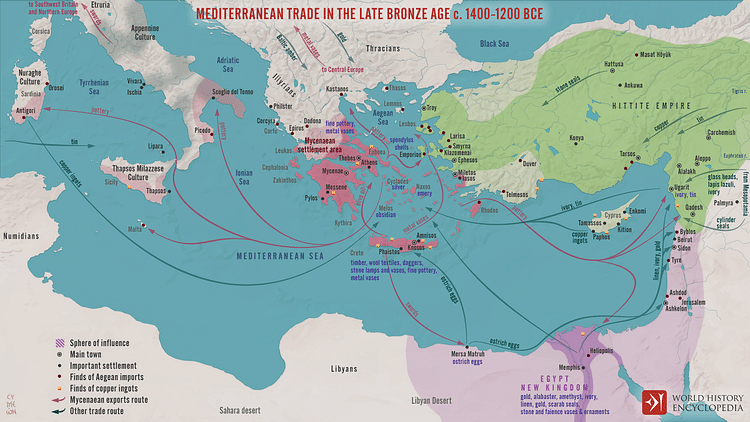
Linear B Features & Decipherment
Linear B script appears most commonly on clay tablets, which are usually small rectangles meant to be held in one hand while the scribe made the marks with the other hand. An alternative but rarer shape is leaf-shaped tablets. Curiously, it is not uncommon to find impressions of the scribe's fingers or palms in the clay. Other sources of Linear B script include stirrup jars, large storage pottery vessels, clay nodules used as seals, clay labels for storage vessels, and on carved seals which bear other non-script markings. Most of the artefacts, particularly the clay tablets, date to the 13th century BCE, but there are examples from the 14th century BCE. The latter are mostly from Knossos where the first examples of the script were discovered during the excavations made by Arthur Evans (1851-1941) in March 1900.
The Linear B script is summarised as follows by the Encyclopedia of Ancient History:
The script was syllabic, with phonetic signs representing a vowel or consonant plus vowel: the town Amnisios, for example, was spelled a-mi-ni-so. There were also signs for numbers, and pictographic ideograms used to represent things the scribes wished to count. (4093)
The Oxford Classical Dictionary adds more details:
The script, which runs uniformly from left to right, is composed of signs of three types. (1) Commodities, including people and animals are noted by special signs called ideograms or logograms, in origin pictorial but often developing into unrecognizable patterns. These stand before numbers to show what is being counted. There are signs of this class to denote the smaller fractions of major units of volume and weight. (2) The numeral signs are decimal-based, signs for 1, 10, 100, 1,000, and 10,000 being repeated up to nine times. (3) The syllabic signs (fewer than 90), usually noting a consonant followed by a vowel, are used to spell out names and vocabulary words. There are signs for the five vowels, but length is not indicated. There are also a small number of signs with the value: consonant+semivowel+vowel…Words are divided but monosyllables are treated as part of the following or preceding word. (1206)
One of the difficulties with deciphering Linear B script was the relative paucity of example texts. Even at the major site of Mycenae, only around 70 Linear B clay tablets have been excavated. This is because the clay tablets were only intended as short-term records, and those which survive today are those which were baked hard in accidental fires. Fortunately, there are thousands of other artefacts bearing the script from Mycenae besides clay finds. Artefacts with painted script and tablets have been found at other Mycenaean sites like Pylos (the single most important site for Linear B tablets), Thebes, Tiryns, Chania, Agios Vasileios, and Midea. It is curious that very few artefacts bearing the script have been found at smaller settlements (which is not the case with the Linear A script). As a consequence of ongoing excavations across Greece, today archaeologists have over 5,000 examples of Linear B script in clay alone.
Despite the difficulties of limited administrative use and relatively short pieces of text, Linear B script was deciphered by the architect Michael Ventris (1922-1956) in 1952, who then published his research in collaboration with John Chadwick. Suddenly, scholars could access the language of the Bronze Age Greeks and extend their knowledge by going back a further five centuries than was previously possible. There is one caveat, though, and that is "that Linear B is not suitable for giving satisfactory reproduction of the Greek language, and consequently each group of signs, i.e. each word, can be read in a number of different ways" (Alexiou, 130). This fact and the abstract nature of many signs of Linear B mean that sometimes the full meaning of a text is debated by historians.
Uses of Linear B Script
The Linear B script was primarily used for record-keeping, and so we have clay tablets listing such items as foodstuffs (e.g. grain, figs, olives, olive oil, and wine), livestock (e.g. sheep, cattle, goats, and pigs), weapons (arrows, spears, javelins, and swords), furniture, chariots, and raw materials like wool, timber, metals, and ivory. Some records go beyond mere lists and note the distribution of raw materials to manufacturing centres, land grants, commodity deliveries, issues of arms, call-ups for warriors and rowers, and the distribution of warriors to specific locations.
Although Linear B script was primarily used for administrative and economic purposes, the script does give us insights, albeit indirect ones, into other aspects of Mycenaean culture. The Linear B tablets themselves are evidence that the large palace complexes of Mycenaean Greece controlled large surrounding territories in some way, not only through the trade and accumulation of goods but also in the coordination of labour. Thanks to the decipherment of Linear B script, we know there were rulers, officials, priests, palace dependents, male and female craftworkers, warriors, herdsmen, conscripted labour, and male and female slaves within Mycenaean society. The large cache of Linear B script tablets at Pylos has allowed archaeologists to note that "only a few dozen scribal hands have been identified, and it is clear that literacy was restricted to a small segment of the population" (Cline, 682).
We know from the tablets that Mycenaean palaces managed specific manufacturing industries such as textiles, bronze weapons and tools, armour, pottery, chariots, glass, and perfumes. Curiously, there is very little Linear B script concerning the export trade of these goods, which is known to have been vibrant from other archaeological sources. Clearly, Linear B script allowed the Mycenaeans to maximise productivity to such an extent that they became major traders in the ancient Mediterranean. Further, the frequent references to armour, chariots, and weapons manufacturing, as well as mention of the distribution of warriors and rowers to vulnerable coastal areas in Linear B script tablets (almost 50% of them), illustrate that the Mycenaeans were capable of defending themselves vigorously against rival civilizations.
Another area of insight revealed by the Linear B script is the Mycenaean religion. We know that gods were honoured with banquets and offerings made at shrines and sanctuaries. The Olympian gods which we associate with later Greek culture, such as Zeus, Poseidon, Hera, Athena, Artemis, Ares, Hermes, and Dionysos, all appear in Mycenaean records. Interestingly, there are, too, deities which did not make it into the religion of Archaic and Classical Greece. For example, the Mycenaeans worshipped female versions of Zeus and Poseidon, called Diwia and Posidaia, respectively. Tablets note the goods offered to the gods during religious rituals; these include grain, honey, spices, textiles, and perfumed oil. Other tablets list goods which were assembled for consumption during festival feasts; these include meat, wine, and cheese. Linear B script has also revealed that the Mycenaeans had a religious calendar with specific named festivals throughout the year. Finally, the tablets show that the Mycenaean priesthood, which included roles for men and women, had a distinct hierarchy.
Mycenaean Decline
The reasons for the demise of the Mycenaean civilization, which occurred in stages from c. 1230 BCE to c. 1100 BCE, are much debated. We do know that several sites were destroyed between 1250 and 1200 BCE as the palace system went into decline. Not all sites suffered destruction, but by around 1100 BCE, most Mycenaean sites had been reduced to mere villages. Warfare with invading Sea Peoples, natural disasters, overpopulation, internal unrest, and climate change may all have contributed to the demise of the Mycenaean civilization and, with it, the disappearance of the Linear B script. There is no connection between Linear B script and the Greek alphabet Archaic Greeks borrowed from the Phoenicians, although the Mycenaean spoken language is regarded as a dialect of the later Greek language, with particular similarities to Classical Arcadian and Cypriot.
